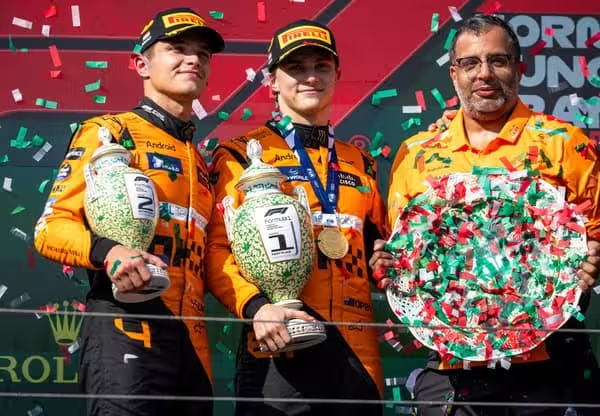Team orders. While very much a part of Formula 1, team orders still hold a somewhat taboo reputation. The officials hate to see it, the teams hate to use it, and the drivers, more often than not, hate to follow them. All three instances were evident in the Hungarian Grand Prix on Sunday (July 21st), and McLaren found themselves embroiled in another team orders controversy.
First, let’s congratulate Oscar Piastri on his first F1 win. The Australian took the lead with a bold start from P2 and beat a seven-time world champion in Lewis Hamilton, a three-time world champion in Max Verstappen, and a no-time world champion in McLaren teammate and sometime loose cannon Lando Norris.
Let’s now look back to 1998, back to a time when Verstappen was just a year old, and likely crying just a little bit more than he does now. Norris was a year from being born, and I have to guess that while in utero, Norris refused to vacate his mother’s womb until doctors induced labor, and he finally arrived three days early.
Anyway, at the 1998 Australian Grand Prix, the first race of the season, McLaren teammates Mika Hakkinen and David Coulthard started 1-2, respectively. The team determined that the driver who won the race to the first corner would be the team’s priority in winning the grand prix. Hakkinen was first to the corner and thus in the driver’s seat for the win.
(Side note: It seems preposterous that team orders would even be discussed, much less employed, in the season’s first race. That’s like a golfer using a mulligan on his/her first shot of a round. Or Bernie Ecclestone paying taxes before he even knows he owes taxes. I know F1 has had difficulty regulating team orders, but can they at least ban them in, say, the first ten races of the season? Team orders, for the most part, are used to ensure that a driver scores maximum points towards the world championship. The first ten races for a team(s), in the hypothetical “no team orders in the first ten races” scenario, should be used to establish which driver has more points and is in line to benefit from team orders once they become legal after ten races).
Back to the 1998 Australian GP. Midway through the race, a so-called “phantom” radio communication brought Hakkinen in for an unscheduled pit stop, allowing Coulthard to inherit the lead. Long story short, Coulthard, later in the race, slowed to let Hakkinen by for the race win.
Controversy ensued,…
Click Here to Read the Full Original Article at …

